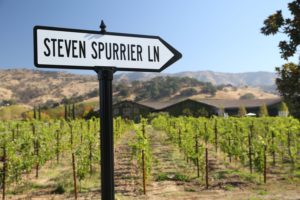
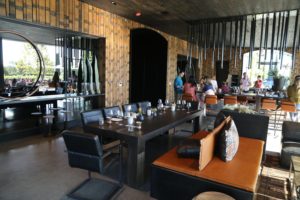
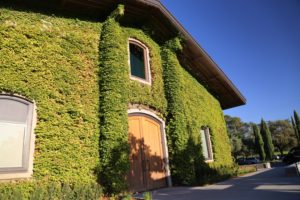 Clos du Val (founded in 1972, means “small vineyard estate of a small valley” in French) is still under original ownership. The winery was founded by an American businessman and prolific patron of the arts, John Goelet (died in early 2023 at age 91) & his wife Henrietta. Goelet lived a very full life; he was the son of a French mother and an American father. Wine was not something new to his family; his grandfather through his mother’s side of the family operated the Bordeaux based wine merchant Barton & Guestier. Goelet graduated from Harvard University where he studied Arabic and Farsi. He was involved in a number of agricultural pursuits over the decades including starting an agricultural seed company in Turkey and operating a cattle ranch and potato farm in Idaho.
Clos du Val (founded in 1972, means “small vineyard estate of a small valley” in French) is still under original ownership. The winery was founded by an American businessman and prolific patron of the arts, John Goelet (died in early 2023 at age 91) & his wife Henrietta. Goelet lived a very full life; he was the son of a French mother and an American father. Wine was not something new to his family; his grandfather through his mother’s side of the family operated the Bordeaux based wine merchant Barton & Guestier. Goelet graduated from Harvard University where he studied Arabic and Farsi. He was involved in a number of agricultural pursuits over the decades including starting an agricultural seed company in Turkey and operating a cattle ranch and potato farm in Idaho.
Besides their involvement in the world of wine, John and Henrietta founded the Bhutan Foundation in 1986 whose focus in part is on preserving that country’s culture and conserving their natural resources. Maintaining offices in Washington, DC and in Thimphu this non profit raises millions of dollars every year to support the four pillars of Bhutan’s Gross National Happiness (GNH); these include: environmental conservation, sustainable development, cultural preservation and good governance.
John also owned and was the CEO of The Satmar Company, one of Europe’s (France) largest oyster companies and the inventors of clam farming but since transferred ownership to his grandchildren. In 2018 he also transferred ownership of Clos du Val to his six grandchildren. Today one of the grandsons, Olav Goelet who formerly worked at Island Creek Oysters in Duxbury Bay, MA has taken over ownership and management of Clos du Val as CEO.
John hired French winemaker Bernard Portet (who we originally met with) to look for premium wine regions outside of France to grow and produce Bordeaux style wines. Wine education for Bernard began early in life – his father was a technical director at Château Lafite Rothschild; Bernard was raised tasting vintages every year from this storied winery. Bernard came to Napa Valley in 1970 and determined the site location for Clos du Val Winery in part due to a broken air conditioner – while driving the Silverado Trail with his hand out the window he noticed at a certain point the temperature dropped as he drove southward indicating cooler temperatures he preferred for his style of wines. This was in the southern part of Napa Valley near the site of present-day Clos du Val.
Bernard oversaw the planting of their initial vineyards including Zinfandel with Dick Steltzner; Bernard was the founding winemaker in 1972. Bernard’s style of wines never wavered over the years – he was trained in classic French winemaking. He told us, “My wines are a reflection of culture” referring to France where meals are usually accompanied by wine. In the early 1970s at Clos du Val, he began crafting wines that were balanced and were meant to pair with foods; these wines were also blended to bring out additional complexities. This was opposite of many winemakers at the time who were trying to preserve varietal characteristics (single varietal wines) and were trying to highlight the richness of the Napa fruit both in the aromas and on the palate.
It was his first vintage (1972) that was one of only several Cabernet Sauvignon wines selected for the now historic famous Judgment of Paris tasting of 1976; the Clos du Val entry placed 8th among the judges in the California Cabernet Sauvignon vs. red Bordeaux tasting of which there were 10 entries, 5 of which were from Napa Valley. Ten years later in 1986, the same wine took first place in a rematch of the original 1976 Judgement of Paris entrants.
It is interesting to note that this 1972 vintage was not made from Clos du Val estate fruit, nor was it made in their own winery – as neither their vineyards were mature yet nor was their winery built. They purchased fruit from Park-Muscatine vineyard on Howell Mountain (loads of history behind the ownership of this particular vineyard) and also from several of their Stags Leap District neighbors. And the wine was made at what was Cuvaison in the northern part of the valley near Calistoga. For many years, Cuvaison was a popular custom crush winery, renting out space to wineries that did not own their own physical winery space. For some years the Clos du Val wines were also stored and aged at nearby Occidental Winery (built in 1878 by Terril Grigsby) and today owned by the Regusci family (Regusci Winery).
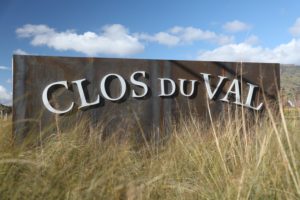
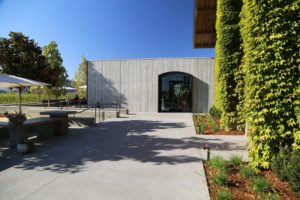
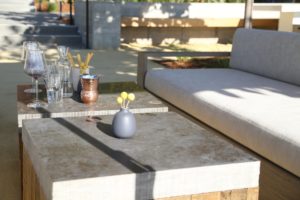 And in a nod to this historical tasting, the driveway into the winery is named Steven Spurrier Way – an homage to the British wine expert who organized the original Paris Tasting. For a few years a sign stood next to the driveway indicating this, but has since been removed. As as result of their French connection one will always see a French flag flying next to the American flag at the entrance to their driveway. Very international in scope, the parent company, Goelet Wine Estates also owns vineyards and a winery in Tasmania and Victoria, Australia (see our notes at the end of this review).
And in a nod to this historical tasting, the driveway into the winery is named Steven Spurrier Way – an homage to the British wine expert who organized the original Paris Tasting. For a few years a sign stood next to the driveway indicating this, but has since been removed. As as result of their French connection one will always see a French flag flying next to the American flag at the entrance to their driveway. Very international in scope, the parent company, Goelet Wine Estates also owns vineyards and a winery in Tasmania and Victoria, Australia (see our notes at the end of this review).
In addition to the Hirondelle Vineyard (the name means swallow in French – and since the winery was built, these birds return every spring to nest on the sides of the building) located on their estate property with its 100 acres of vines, Clos du Val also owns two vineyards near Yountville: State Lane Vineyard with approximately 18 acres to vine and the Riverbend Vineyard, a 100-acre site. In addition, for many years they owned 180 acres off of Old Sonoma Road in Napa’s Carneros District (the Grand Val Vineyard) until they sold this property to Far Niente in mid 2021.
While Clos du Val is known for Cabernet Sauvignon, because of the variety of property they own in the Napa Valley they do make other wines. As of our latest update to this review, all their wines are estate grown with the exception of a Riesling that they source from a vineyard in the Petaluma Gap of neighboring Sonoma County. Tastings typically include a rosé of Pinot Noir, a Merlot, a Petit Verdot and several of their Cabernet Sauvignon wines. These are wines that are distinctive and rather than noted for their similarities, they are noted for their differences, their nuances and always a sense of place.
And Clos du Val played a role in supporting the early years of the founding of Chamber Music in Napa Valley (founded 1980) including Portet’s help, along with the organization’s founder Dick Lemon (a lawyer and also a co-founder of Luna Vineyards). The reduced priced concerts continue to be offered in Napa Valley and have attracted a variety of performers over the years including the accomplished pianist, Emanuel Ax.
Select Wines
Whites/Rosé
The 2022 Clos du Val Sauvignon Blanc Napa Valley is deep straw in color; the bouquet quickly reveals its aromatic character showcasing plenty of fruit including honeysuckle, pineapple, citrus blossom, chamomile, lemon, Gravenstein apple, pineapple guava, kiwi and passion fruit. It smells floral, fruity and fresh. And there is a light herbal note but in no way is the bouquet green or grassy. The palate sports flavors of pineapple guava, comice pear, Granny smith apple, apricot and mandarin orange. It is flavorful, balanced and built upon the back of an energetic acidity. And this vibrancy is especially felt on the lively and flavorful finish. Best paired with a variety of shellfish including mussels, oysters and clams.
The 2023 Clos du Val Rosé of Cabernet Franc. This wine is medium copper in color. The minerally bouquet offers aromas of raspberry, rose petals, graphite, kumquat, citrus blossom, lime zest and a hint of mint. Fleshy across the palate its texture is complemented nicely by a bouncy acidity. And there are flavors of mandarin, raspberry, watermelon, pomegranate and strawberry. Balanced, bright and beautiful. A summertime sipper by the pool. Or a spring salad lightly drizzled in olive oil and vinegar with a light pinch of garlic salt. Or grilled halibut. Drinking this wine is simply making us hungry.
Reds
The 2022 Clos du Val Malbec Hirondelle Estate Stags Leap District is a blend of 75% Malbec, 18% Cabernet Sauvignon, 5% Carménère and 2% Merlot. This wine is deep ruby and opaque in the grass with an amaranthine rim. The bouquet is dark blue and purple berry fruited including aromas of Persian boysenberry, mulberry, blackberry, blueberry, blood orange and a note of bittersweet and dark chocolate. As fruit forward on the palate as on the bouquet, there are flavors of blackberry, boysenberry, blueberry, dark cherry at the peak of its ripeness. The tannins are lightly grainy but tumbled and are already well integrated into the dark fruited finish only two years post vintage at the time of our tasting. The dusty character persists for sometime on the front of the palate. Napa Valley doesn’t produce too many single varietal bottled Malbecs, this is one of the finer examples. From personal experience, this wine shines especially well when paired with grilled pork shoulder.
The 2022 Clos du Val Cabernet Franc Hirondelle Estate Stags Leap District is 84% Cabernet Franc, 12% Cabernet Sauvignon, 2% Merlot and 2% Carménère. This wine is deep ruby and opaque. Fully ripe, the nose offers a union of dark fruits and savory characteristics. These scents include lavender, plum, boysenberry, a minerally character including chalk and a note of rusting iron and or a sanguine character. And as the wine evolves, it reveals a very subtle hint of cocoa powder. Bright and balanced in its youth, the palate sports flavors of plum, bramble, blueberry, sage, black tea and dark olive. The savory and lively finish is supported by grainy and gritty tannins paralleling the fruit for sometime before both drop off. We would like to pair this with a tenderloin cut of Wagyu steak.
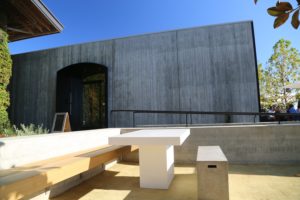
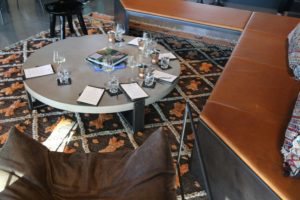
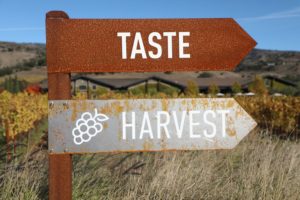 The 2021 Clos du Val Cabernet Sauvignon Napa Valley is 86% Cabernet Sauvignon, 7% Merlot, 5% Malbec, 1% Cabernet Franc and 1% Petit Verdot. This wine is deep ruby in color; the bouquet offers fresh, youthful and lively aromatics focusing on fruit including scents of plum, bramble, red cherry, currant, raspberry, dried herbs and layers of dark chocolate, mocha and a woodsy/pepper spice which shows more as the wine evolves. Red fruits dominate on the palate including of cherry, plum, and cranberry. The finish features grainy and not yet fully resolved tannins which are felt more on the front of the palate than the back, toasted oak, crushed peppercorn and a light warmth of alcohol and a drying character. We tasted this wine only two years post vintage. We immediately thought of pairing this wine with lamb chops seasoned in various herbs including rosemary, pulled right off of the BBQ.
The 2021 Clos du Val Cabernet Sauvignon Napa Valley is 86% Cabernet Sauvignon, 7% Merlot, 5% Malbec, 1% Cabernet Franc and 1% Petit Verdot. This wine is deep ruby in color; the bouquet offers fresh, youthful and lively aromatics focusing on fruit including scents of plum, bramble, red cherry, currant, raspberry, dried herbs and layers of dark chocolate, mocha and a woodsy/pepper spice which shows more as the wine evolves. Red fruits dominate on the palate including of cherry, plum, and cranberry. The finish features grainy and not yet fully resolved tannins which are felt more on the front of the palate than the back, toasted oak, crushed peppercorn and a light warmth of alcohol and a drying character. We tasted this wine only two years post vintage. We immediately thought of pairing this wine with lamb chops seasoned in various herbs including rosemary, pulled right off of the BBQ.
The 2015 Clos du Val Petit Verdot, Napa Valley (a rare 100% wine of this varietal for a Napa based producer) is noticeably dark ruby/purple in the glass; it is briary and savory with lots of red fruit on the bouquet and some floral undertones as well as a hint of milk chocolate as the wine opens. Shows dark fruit on the palate including blackberry and plum – this wine is dense; it has a certain ‘stuffing’ if you will. Well textured the tannins are still a bit tight in their youth and they linger along with hints of cedar, darker spices and plenty of fruit on the long finish. Also noteworthy, the wine features excellent acidity.
The 2015 Clos du Val Estate Cabernet Sauvignon, Hirondelle Vineyard offers a pretty bouquet, initially with aromas of cigar smoke, a tobacco leaf nuance, hints of clove along with red fruits. It reveals a lively palate with bright and dancing fruit showcasing excellent acidity. Very balanced, the tannins are fairly well integrated and smooth and a bit dusty in nature. The finish also lingers with a slight red cherry tartness.
The 2013 Clos du Val Estate SVS (special vineyard select) Cabernet Sauvignon is blended with 7% Merlot. Very approachable in its youth, one drinks this wine without analyzing it to closely, it is simply fun to consume. Plenty of bright berry fruit aromas – blueberry, blackberry and even a touch of boysenberry aromas show on the bouquet. Juicy on the palate this wine is all about the fruit rather than any secondary characteristics from the oak aging. Features supple tannins which are slightly earthy in nature.
Perhaps their most acclaimed wine, the Three Graces, is named after a sculpture created in the year 1624 by the German artist, Georg Petel who modeled his gilded bronze piece after the painting of the same name by Peter Paul Rubens. Petel actually saw Ruben’s painting prior to creating his own sculpture. The piece changed hands a number of times over the years, in 1969 John Goelet acquired this rare piece and owned it until 1976 before donating it to the Museum of Fine Arts, Boston (now a part of their permanent collection).
Museum of Fine Art, Boston – Three Graces
For those who want to visit this iconic bronze piece, Three Graces is on permanent display in a small room within the European collection at the museum. One expects a large sculpture, but in reality, the piece is merely a few inches tall and displayed in a glass case built into the wall with a number of other objects. The statue portrays three nude women, each representing a singular trait: splendor, mirth and joy. The image has appeared on the labels of all Clos du Val wines since their inaugural vintage of 1972. We visited Boston specifically for the purpose of photographing the Three Graces (see our photos at the bottom of this review).
The 2014 Clos du Val Three Graces Cabernet Sauvignon is a blend of 99% Cabernet Sauvignon and 1% Cabernet Franc hand selected from the finest blocks on the Hirondelle Estate Vineyard. The bouquet is immediately intriguing – it is well layered with many aromatic angles, a wine that as it breathes continues to reveal layers of aroma. The bouquet offers pretty aromatics including red and dark cherry, a hint of dry dust, toasted oak and cedar. The entry sports a softness which very quickly evolves to power and richness of flavor. The wine is well concentrated with sizable chewy and dusty tannins anchoring a powerful and long finish; it shows power, yet also simultaneously, restraint. Regardless, this is a wine built for the long term and should age well for many years to come.
Harvest Farmers Market
This annual well-worthwhile attending event is held at Clos du Val every early October. Its a celebration of harvest, featuring local purveyors selling a variety of artisan products including coffee, cheeses, olive oil, fresh vegetables, baked goods, honey and lots more. Admission includes lunch and tastings of both current release Clos du Val bottlings plus samples of older rarer vintages. And a nice touch is the provided bouquet of freshly cut flowers available to all attendees and the stylish Clos du Val wine tote.
Every event has a certain vibe; the vibe here is casual, family-friendly, fun and one built around an exploration of food, wine and assorted products. Its always held on Sundays so despite harvest, even a few winemakers often attend.
—
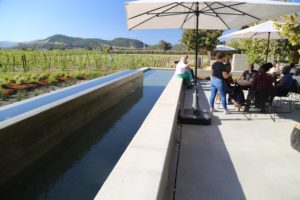
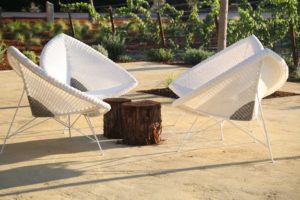 Their prior small tasting room used to become quite crowded especially on the weekends. In late 2017, Clos du Val broke ground on a 3,000 square foot hospitality center, called the Hirondelle House, located roughly in front of their existing barrel room and winery. This exciting and contemporary space opened in early October 2018 and offers a larger and more relaxed space for guests. The focus of visits are on personalized sit-down tastings – either inside the Hirondelle House or if the weather permits, outside on the patio. This is an ideal place to watch the setting sun in the late days of summer or into autumn.
Their prior small tasting room used to become quite crowded especially on the weekends. In late 2017, Clos du Val broke ground on a 3,000 square foot hospitality center, called the Hirondelle House, located roughly in front of their existing barrel room and winery. This exciting and contemporary space opened in early October 2018 and offers a larger and more relaxed space for guests. The focus of visits are on personalized sit-down tastings – either inside the Hirondelle House or if the weather permits, outside on the patio. This is an ideal place to watch the setting sun in the late days of summer or into autumn.
The winery and hospitality center are located just off the Silverado Trail in the well-known Stags Leap District. Guests can visit the property for a tasting without having a reservation although reservations are recommended, especially so for later in the day tastings on busy summer or autumn weekends. In addition to their primary tastings, guests can also opt for additional experiences including a tour of their cellar followed by a private tasting, a library only tasting, or a seasonal tasting in their olive grove with select Clos du Val wines paired with a provided lunch.
Brown is decidedly the color of choice here as it graces their labels, tablecloths, is the color of the chill buckets and even the napkins are brown. Often older wines will be available for sale at the winery. Total production as of our last update is around 45,000 cases per year, significantly lower than their 90,000 cases/year at one point.
And in a creative use of their original tasting room, this space has been converted into The District Experience, featuring wines on tap by the glass, through a flight, or by the bottle. Weather permitting guests are allowed to sit outside in the garden area; this tasting is available by walk-in if space is available.
Clos du Val often sells select vintages of library wines dating back 10 to 15 years. For more information or to join one of several membership levels in the Coterie club (for access to wine-club member only wines and exclusive winery events), visit: www.closduval.com
Winery/Grounds
Riverbend Vineyard, Yountville
Grand Val Vineyard, Carneros NOTE: as of mid 2021, this vineyard was sold to Far Niente and is no longer owned by Clos du Val. We keep these photographs here for historical reference.
GOELET FAMILY OWNED PORTFOLIO OF PROPERTIES
The Goelet’s founded Domaine de Nizas in southern France in 1998. They sold this winery in 2018. They sold both of their Australian/Tasmania wineries in 2024 including Taltarni and Clover Hill. In addition to Clos du Val, the Goelet family currently owns Domaine de Sandricourt near Paris.
Domaine de Sandricourt, France
This historical estate and chateau is located about a 45 minute drive north west of Charles de Galle Airport in Paris. The property is 5,436 acres including several thousand acres dedicated to a variety of agricultural crops in addition to forested land. They have had success growing currants and there are fields of these bushes within a short drive of the chateau. Robert Goelet (John Goelet’s father) purchased this estate in 1908.
The chateau was built in the 1800s and features 10 rooms available for rent on both the first and second floors. The estate also features a park designed between 1880 and 1900 by Henri and Achille Duchêne, well-known French landscape architects.
There are numerous perks to a stay here; one includes access to the Goelet family chef who can prepare meals for guests including pairing wines from Clos du Val. And shooting skeet. During our visit to the property we noticed numerous wild pheasants (both male and female) roaming the grounds and nearby fields.
We visited the grounds of Domaine de Sandricourt but have not yet made a proper tour of the property. We will be back in France again, most likely in late spring 2025 and will stop by here again.
We were planning to visit Australia in late 2024 with the mission of visiting Clover Hill and Taltarni wineries. However, the Goelet family sold them in August 2024 to the Fogarty Family Wine Group. We leave our notes here for historical references.
Clover Hill, Tasmania
This winery was founded in 1986 on the site of a former dairy farm by the Goelet family. The focus of their production is entirely on sparkling wines. Clover Hill is located about a 35 minute drive north of the closest town with an airport, Launceston. From Melbourne, flights are about an hour to Launceston. Wines are made méthode traditionnelle from three traditional grapes varieties used in Champagne, France; these include Chardonnay, Pinot Noir and Pinot Meunier. The first wine produced and released was from the 1991 vintage.
Taltarni Winery, Victoria Australia
The Goelets also owned Taltarni Winery, established in 1969 with their first vintage from the early 1970s and released in 1977. This winery was one of the original wineries founded in the Pyrenees wine region; grapes were first planted in the Pyrenees in 1858. The vineyard and cellar door are located just over an hour driving distance northwest of the old gold mining town of Ballarat (about 2.5 hours from Melbourne).
The property is 1500 acres of which 250 acres are planted to vines. Like in and around Ballarat, this area was noted for its gold mines prior to vineyards being planted. The early focus based on the varieties planted were on red wines from Bordeaux varieties. Later their vineyards were diversified and today they produce a variety of both red, white and sparkling wines.
Dominique Portet Cellar Door, Yarra Valley Australia
Founding Clos du Val winemaker, Bernard Portet’s brother Dominque Portet, worked at Clos du Val from 1972 through the 1974 harvest. We met him briefly at his own winery, Dominique Portet which he founded in the Yarra Valley about an hour outside of Melbourne. The winery and visitor center are located along the Maroodah Highway in an area known as the “golden mile” named for several premium producers located along this stretch of the road.
The Yarra River Valley is well-known as a cooler climate wine region; similar to Napa Valley grapes were first planted in the region in the 1830s. The number of wineries today has grown significantly especially over the past 20 years; today there are over 80 cellar doors in the Yarra Valley. Prominent varieties include Chardonnay and Pinot Noir along with Cabernet Sauvignon and Merlot among others.
Dominique Portet produces a number of wines ranging from several sparkling wines to a rosé (at the time of our visit this one wine composed about 1/2 of their overall production), a Merlot, several Cabernet Sauvignon wines and a Shiraz.
Visits to the property are by walk in – a small bistro is located next to the tasting room (reservations recommended) and some outside seating is available with gorgeous views overlooking an expansive lawn with vineyards in the distance.
Like Bernard, Dominique worked at Chateau Lafite Rothschild in Bordeaux (their father André Portet was the winery and vineyard manager at this storied winery). Dominique’s wines tend to have restraint, good acidity and while are certainly built to age are remarkably approachable in their youth. And from the short time we spent at his winery, we could see he is not a hands-off owner – doing tractor, work, cleaning the grounds and popping by the tasting room to speak with staff and guests.

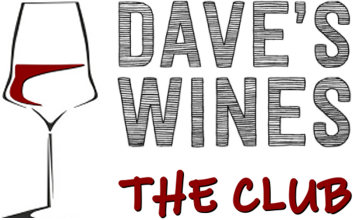








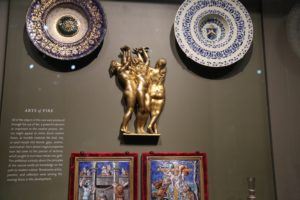



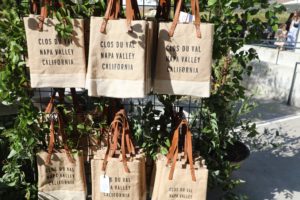
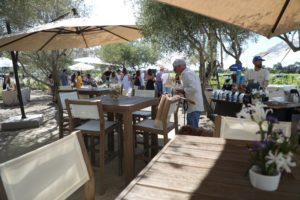

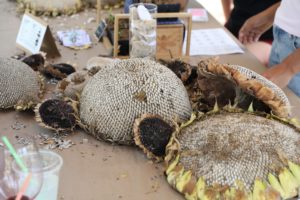
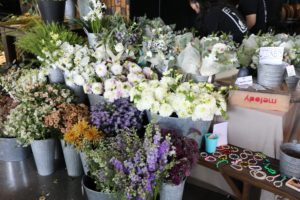
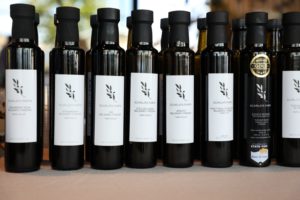
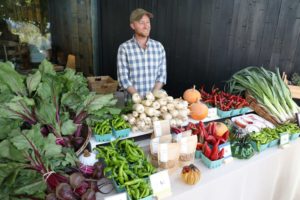
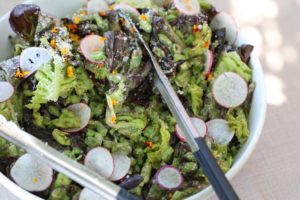
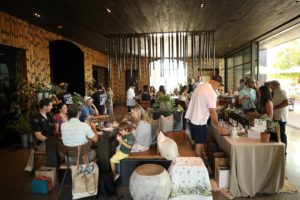
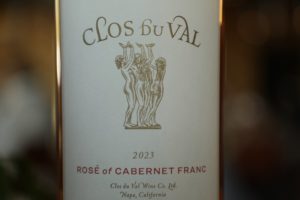
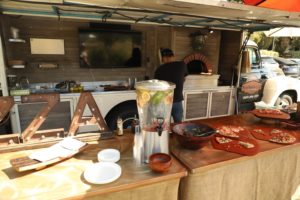
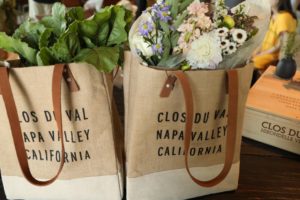
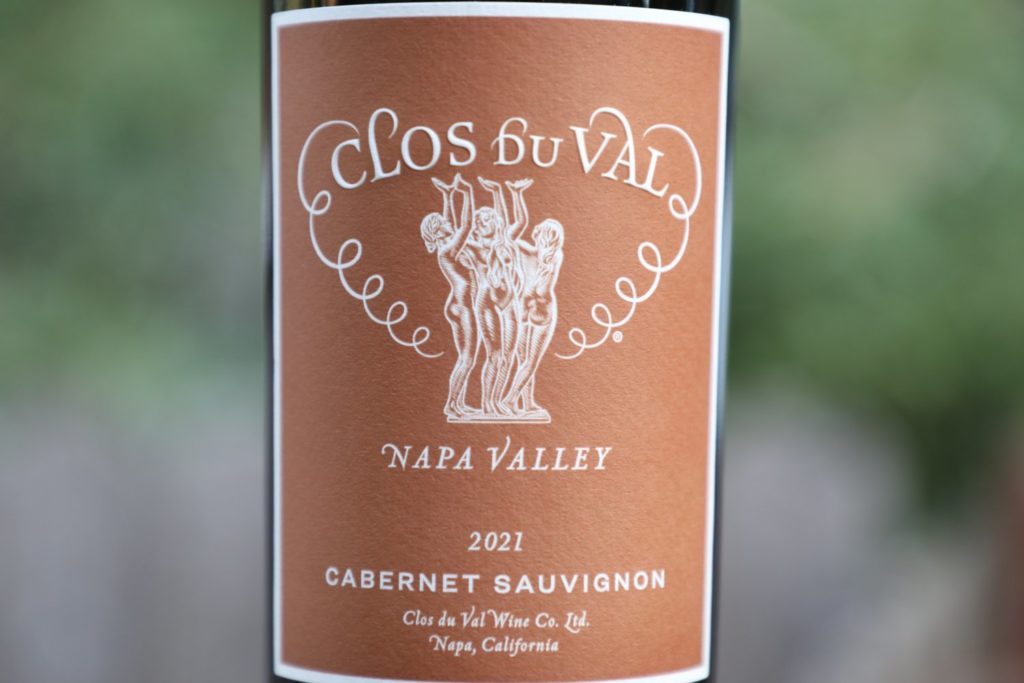
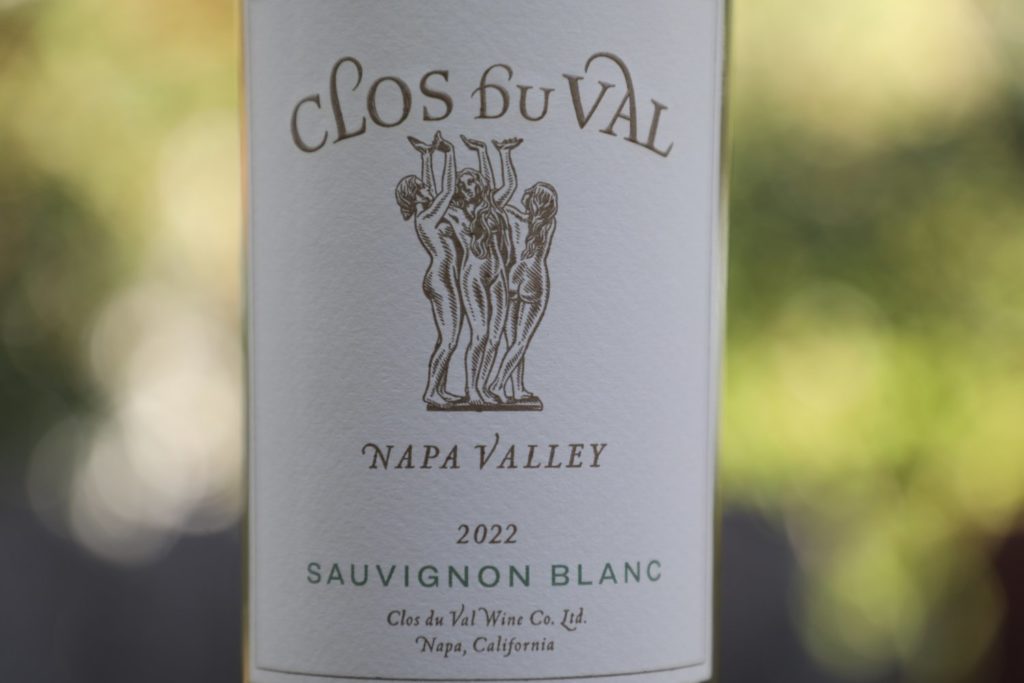
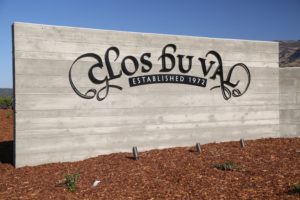
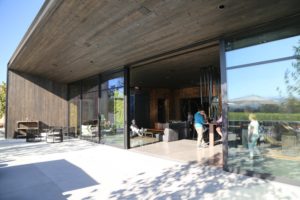
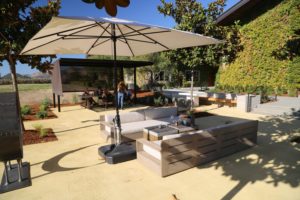
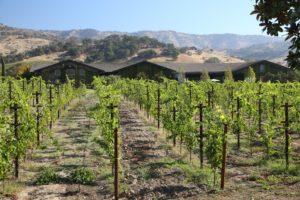
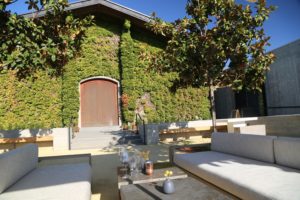
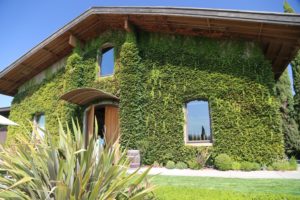
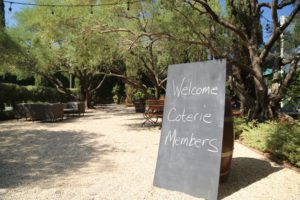
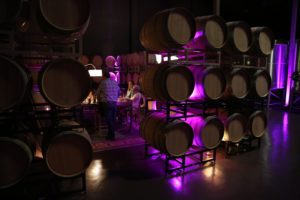
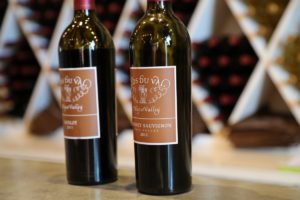
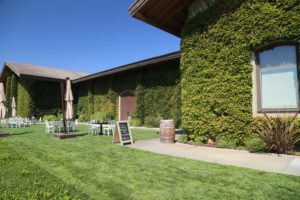
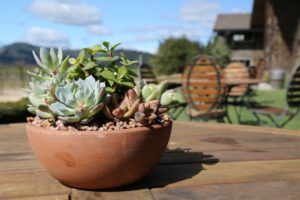
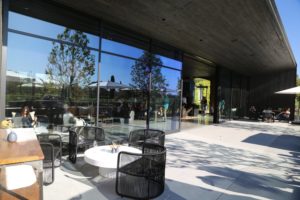
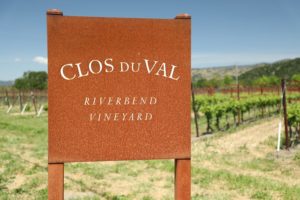
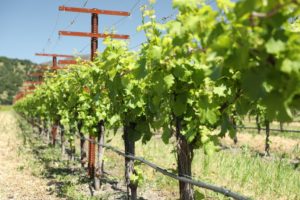
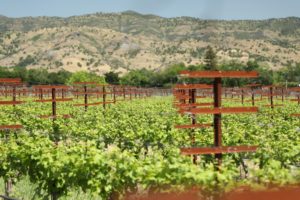
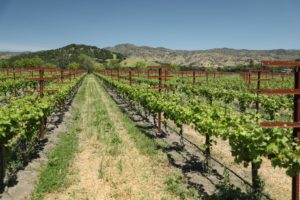
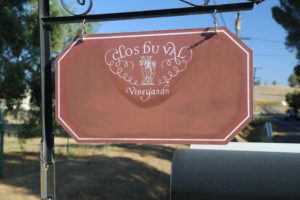
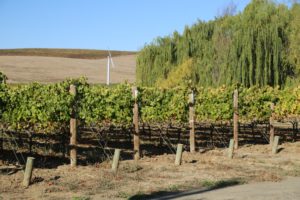
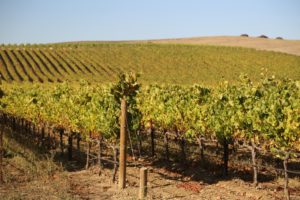
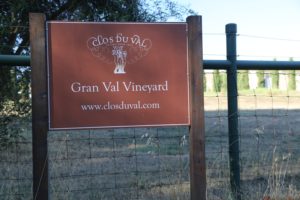
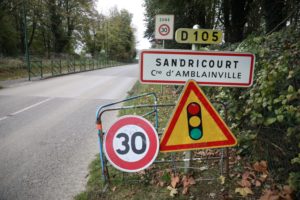
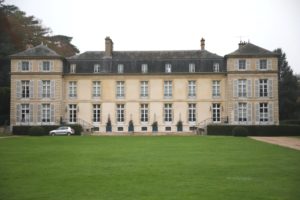
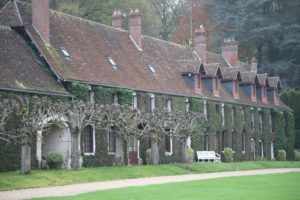
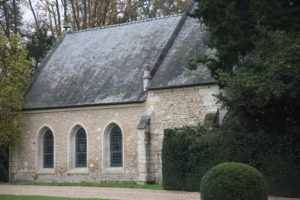
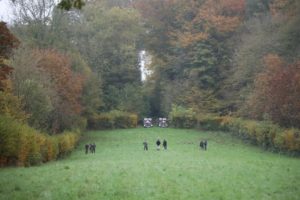
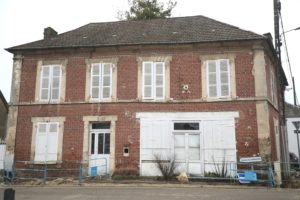

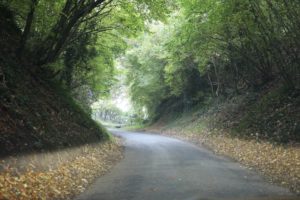
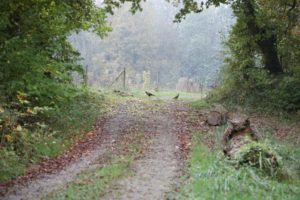

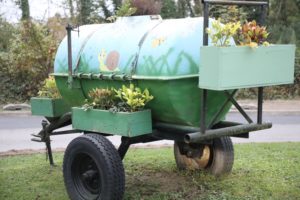

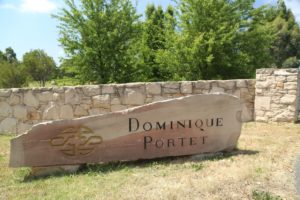
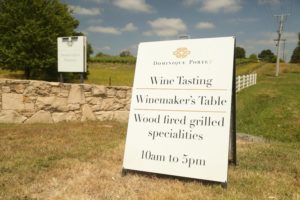
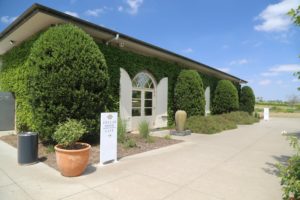
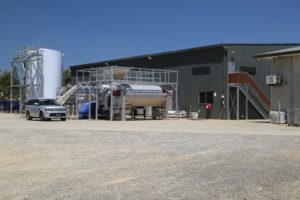
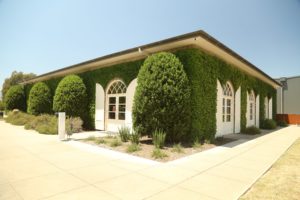
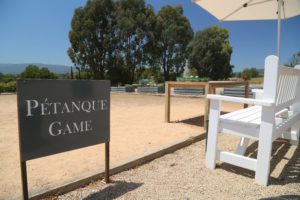
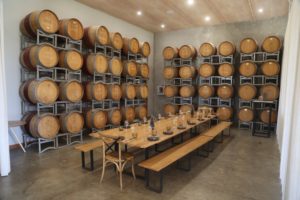
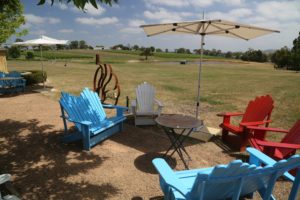
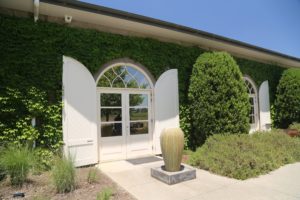
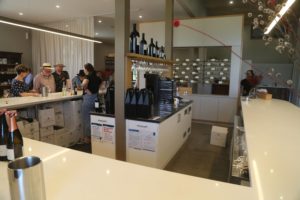
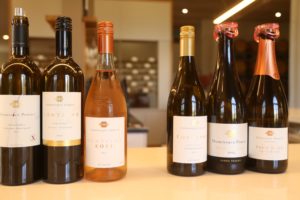
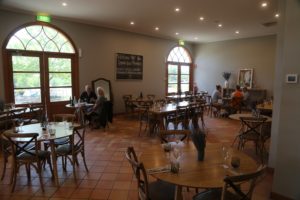
We are looking forward to visting the international spaces owned by the Goelet family as time and budget allows.